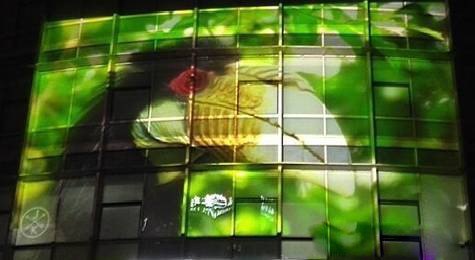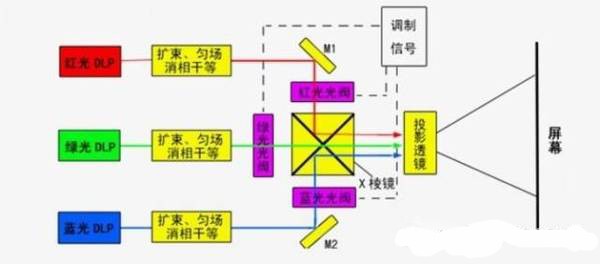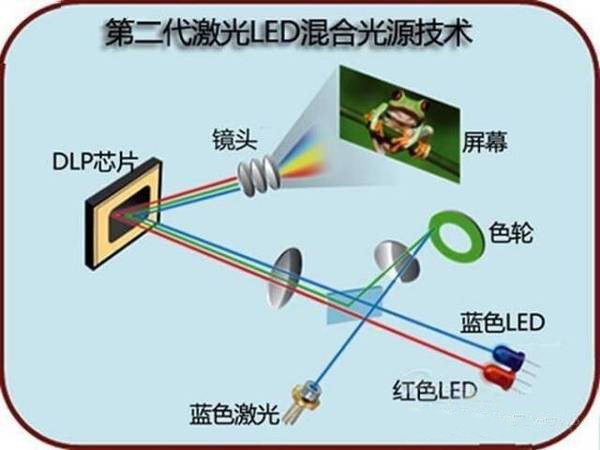In 1640, a Jesus priest named Athanus ç‚雪, born in Gaisal, Germany, invented a slide projector called the "magic" lamp, the world's first projector. After three and a half centuries, EIKI produced the world's first 16mm film projector in 1953. In 1989, SHARP launched the world's first single-chip LCD video projector. In 1989, Epson produced the world's first LCD projection. In 1991, InFocus successfully developed the world's first data projector.

Since the advent of the world's first data projector, the light source used in projectors has been constantly changing through the continuous innovation and research of technology by researchers. From the initial halogen lamps, high-pressure mercury lamps, xenon lamps to new LEDs, lasers and other new light sources have been touched. Nowadays, laser light source-based laser display technology is known as black-and-white display, color display and digital display because of its wide color gamut, long life, high brightness, low energy consumption and unparalleled advantages of traditional light sources. The fourth generation of "heirs."
At present, the laser display technology mainly has three primary colors of pure laser, phosphor + blue light, LED + laser three technologies, each of which has its own advantages and disadvantages. In comparison, the advantages of the three primary color pure laser are more obvious.
From the perspective of their respective technical characteristics and corresponding terminal projection products, the three-primary pure laser is the label of the high-end laser projector. The projection equipment using this technology can easily reach the brightness of more than 20,000 lumens; and the phosphor corresponds to the low-end projection. The highest brightness has just exceeded 10,000 lumens; LED and laser hybrid light source technology is aimed at the low-end market, and the terminal display device using this technology has a brightness of no more than 3000 lumens.
Below, Xiaobian is a technical comparison, a comparison of the three, for reference only.
Trichromatic pure laser
The trichromatic pure laser is regarded as the most pure laser source in the industry. It has the advantages of rich color and high color saturation. It can display the richest, most beautiful and most realistic colors in nature, and has become a major technological development direction in the field of display technology. Up to now, projection equipment using three-primary pure laser technology has “infiltrated†into simulation, exhibition, conference center, outdoor curtain wall, digital cinema, home theater and other fields, which has great development space and broad market application prospects.

â–²Three-primary pure laser display imaging optical path diagram
The development of the three-primary pure laser source has now gone through two technological processes: the solid-state laser stage and the semiconductor laser stage.
The semiconductor pumped frequency doubled laser is also a solid-state laser light source, which is composed of a semiconductor laser (pump source), a laser crystal, a frequency doubling crystal, an output cavity mirror, etc., and has a complicated laser process, a complicated structure, a complicated production process, and poor stability. , poor reliability and other characteristics. The semiconductor pumped frequency doubled laser has a single center wavelength, its spectral width is within 3 nm, and the mode is a single mode light source, which greatly contributes to the generation of laser speckle, and the speckle particles are very large, which makes the dissipating plaque process very complicated.
The semiconductor laser light source is a micro laser developed based on the semiconductor chip preparation technology. It is similar to the LED chip production process, and has the characteristics of simple structure, small volume, stable power, high reliability and long life.
In 2014, the three-primary pure laser technology genre was upgraded with a newly developed green-light semiconductor laser, and red, green and blue light entered the semiconductor era. The laser speckle problem that has been difficult to crack has also improved with the introduction of semiconductor technology. Since the spectral width of the semiconductor laser is 6 nm, the longitudinal mode is more, and the output is in the multi-transverse mode, the solution to the laser speckle is greatly improved, and the particle size of the speckle becomes very small, which can be used for the public. Accepted.
The RGB pure laser engineering projector using the latest pure semiconductor laser source uses a laser light source and a projector to separate the design, featuring ultra-high output brightness, ultra-high resolution, long life and extremely high color saturation. At present, the single-channel luminous flux output can easily reach 25000 lumens, the resolution can reach 4096×2160, the 20,000-hour light source attenuation is less than 20%, and it supports 7×24 hours of continuous operation. The optional lens configuration has the advantages of stability, reliability, safety and energy saving. . Mainly used in exhibitions, command and control, video conferencing, stage sets and other fields.
Phosphor + blue light
The laser phosphor display technology uses a single-color laser (ie, blue laser) combined with a variety of color-rotating fluorescent pink wheel technology containing phosphors such as red and green to produce red, blue, and green primary colors.
The laser phosphor light source uses only one set of blue lasers, and the rotation of the multi-color fluorescent pink wheel effectively solves the problem of thermal quenching and heat dissipation of the phosphor, so that the phosphor can work stably under the condition of high-intensity excitation light irradiation, resulting in stable operation. Red, green and blue light; at the same time, the rotation of the multi-color fluorescent pink wheel is used to generate light output of different colors at different times, and finally the output of white light/color light is realized.
Laser phosphor light source technology overcomes the most fundamental technical difficulties in laser display in terms of efficiency and reliability. The light source display terminal has the following features:
· The color is more pure and closer to the international standard gamut value;
·Long life: ≥60000 hours, 10 times longer than UHP lamp (high pressure gas arc discharge lamp);
·High safety and reliability: no need to eliminate coherence, it is safe to the human eye, no blasting hazard.

â–² Schematic diagram of laser light source technology
The application of laser phosphor display technology solves the problems of laser display in terms of cost, environmental protection and user experience. However, due to the nature of its light source, phosphor laser projectors can only be realized with a single-chip DLP, which cannot be applied to the large-screen market due to the monolithic nature.
In addition, the phosphor DLP rear projection box product only changes the life of the light source. Since the wavelength of the three-color laser generated by the phosphor laser product is different from the wavelength of the semiconductor laser, the effect is very general (only equivalent to the three-primary pure laser 1) /4), and the brightness decays fast. The difference between the gamut and the mercury lamp is not large, and the effect is average.
Laser + LED hybrid light source
In the transition phase of LED light source to laser light source technology, a hybrid technology is born. The new laser + LED light source combines the long life and wide color gamut of the two light sources to achieve high brightness and environmental protection. At present, it is mainly used in business and education.

â–² laser + LED new light source technology
The laser + LED hybrid light source technology is to convert red (high-brightness red LED), green (blue laser through phosphor to green), and blue (blue laser), and can be projected through the DLP chip without using a high-pressure mercury bulb. Achieve high brightness projection. One of the biggest advantages of traditional projection bulbs is their long life.
The new hybrid light source combining laser and LED can make the projector light source have a life of up to 30,000 hours, which is 5-6 times of the service life of the ultra-high pressure mercury lamp. Compared to projectors that require lamp replacement, maintenance and operating costs are reduced. And the brightness attenuation is not obvious for a long time, and can maintain vivid image quality for a long time.
The laser + LED hybrid light source combines the advantages of both, and can also create excellent color reproduction performance, making color rendering brighter and more beautiful. Every detail and contour can be clearly reproduced, providing users with realistic, delicate color and image effects, and the display effect is enhanced.
At present, hybrid lasers are mostly used in DLP/LCDs. The red and blue uses lasers, and the green light uses LEDs. This patchwork thing is also a part of the life problem, and the effect is average.
In addition, it is worth mentioning that there is a debate between laser and LED in the display industry. Since the brightness-limited rickets have not been resolved, the LED light source device will shrink. From the perspective of industry development, the best source of light in the market is the laser source. Although LED was once considered a "next generation" source, its prospects are worrying because it is difficult to achieve high brightness. After the introduction of the three-primary pure laser technology, the LED light source has been "abandoned" by some manufacturers.
At this stage, the three primary color laser, phosphor + blue light, LED + laser three laser display technology will coexist for some time; but from the technical deduction point of view, the former will eventually occupy the entire projection market.
Pet Carriers
-Comfortable & Breathable
-Better Care to Your Pets
-Safe and Fashion Design
-Enjoy Trips with Your Pets
EASY CARRIER AND EASY CLEAN – Wear this airline approved pet carrier over the shoulder, secure it in the car with seatbelt, place atop your luggage or carry it with the top handle. Versatile for your cars or all types of travel,and the cozy fleece pet bed can be completely removed and machine-washed.
Customer Experience Comes First: We always stand behind our customers and try best to meet your needs. We have made several upgraded improvements such as thickening shoulder pad sponge, using upgraded breathable mesh and polyester fiber material, which makes the carrier more durable and comfortable.
Enjoy Trips with Your Pet: Our pet carrier is lightweight and portable, you can use it to carry small dogs or cats for biking, hiking, camping, out walking or meeting friends. It allows owners and their lovely pets to have more adventures together, what's more, it's also a great photo prop to take funny pictures for daily sharing.
We are a Chinese pet products manufacturer, our company produces and sells various cat accessories and dog accessories, including Pet Toys , Pet Apparel And Accessories, Pet Collar And Leashes , Pet Beds And Accessories, Pet Cleaning And Grooming Products, Pet Bowls And Feeders , Pet Houses , and Pet Carriers And Travel Products, which are accepted OEM&ODM. Please don`t hesitate to contact me if you need anything.
Pet Carriers,Pet Bag,Pet Carrier Bag,Dog Carrier Bag
Jilin LOYO Pet Products Co.,Ltd. , https://www.loyopets.com